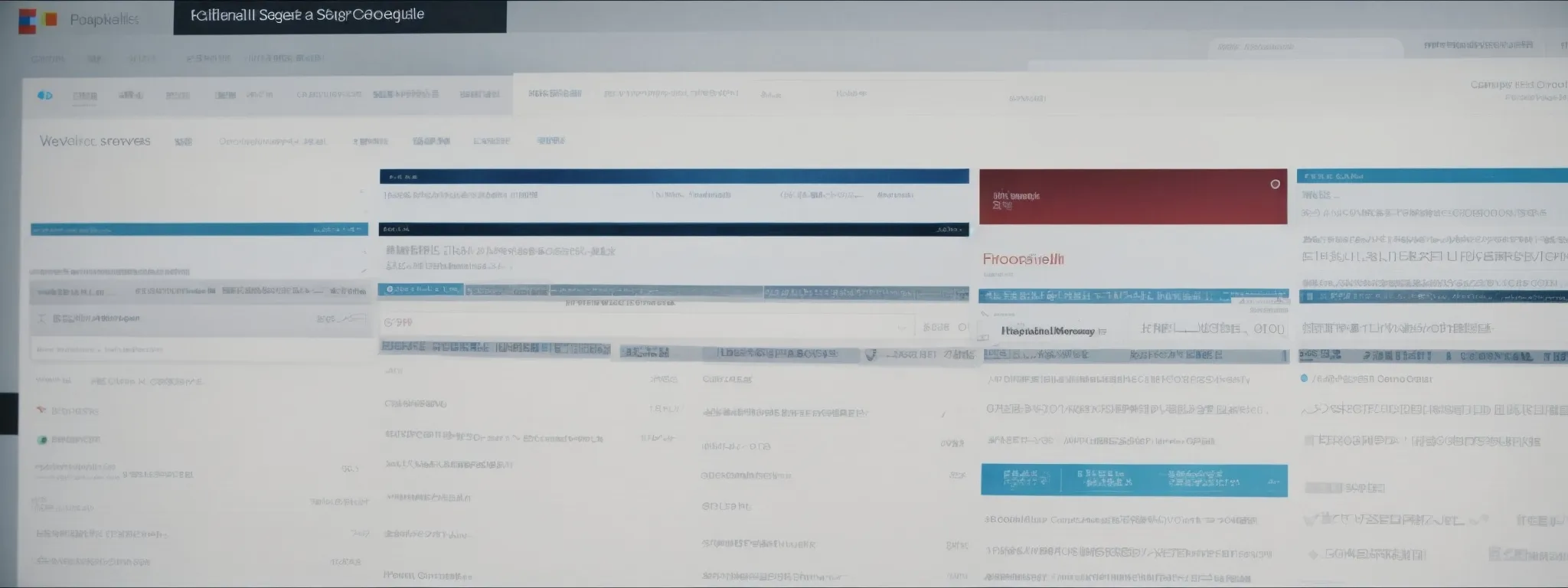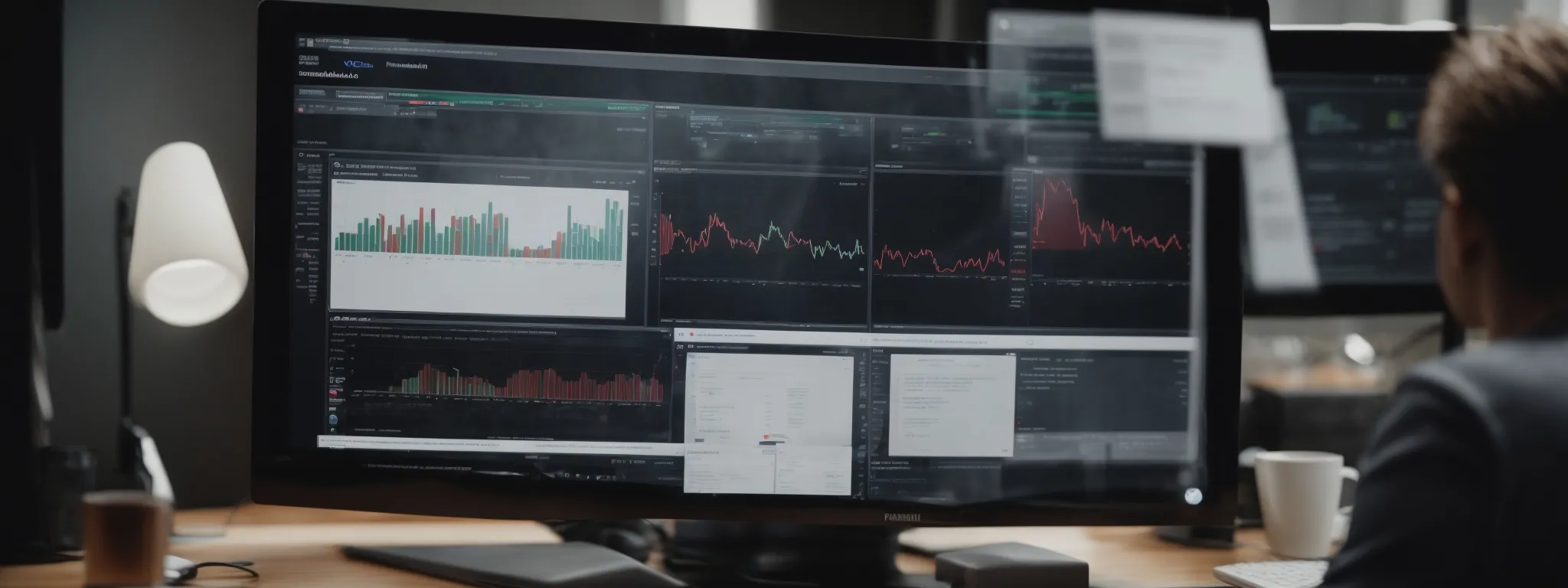Understanding RankBrain: A Deep Dive into SEO
Mastering Google RankBrain: Exploring the Impact on SEO Strategy In the ever-evolving landscape of search engine optimization, Google’s RankBrain has emerged as a crucial determinant in shaping […]
Mastering Google RankBrain: Exploring the Impact on SEO Strategy
In the ever-evolving landscape of search engine optimization, Google’s RankBrain has emerged as a crucial determinant in shaping SEO strategies.
This artificial intelligence system not only refines search results but also scrutinizes how user queries relate to web page content, demanding marketers adjust their approaches.
With an emphasis on understanding user intent and delivering a superior user experience, SEO professionals must finesse their tactics to thrive in a RankBrain-dominated arena.
Grasping the nuances of this powerful ranking signal is essential for any company looking to enhance its search engine ranking.
Keep reading to discover how to adeptly navigate RankBrain’s complexities and integrate them into an effective SEO blueprint with the aid of LinkGraph’s SEO services and the SearchAtlas SEO tool.
Key Takeaways
- Google’s RankBrain Algorithm Leverages AI to Interpret User Intent and Has Revolutionized SEO Practices
- Quality Content and User Experience Are Now Significant Ranking Signals for RankBrain, Surpassing Outdated Keyword-Stuffing Strategies
- LinkGraph’s SEO Services Use the SearchAtlas SEO Tool to Align Content With RankBrain’s Preferences for Relevance and Authority
- High-Quality, Contextually Relevant Backlinks Are Essential for SEO Strategies to Communicate Effectively With RankBrain’s Ranking Mechanisms
- An AI-first Approach, Including Voice Search Optimization, Is Imperative for SEO Strategies to Stay Relevant in the Evolving Digital Landscape
Unveiling Google RankBrain’s Role in Modern SEO

Google’s RankBrain algorithm stands as a cornerstone in the ever-evolving landscape of search engine optimization.
It epitomizes an advanced artificial intelligence system, sculpting the foundation for search engines to grasp the nuanced lexicon of user intent and query context with unprecedented precision.
This evolution has necessitated a recalibration of SEO strategies, prompting professionals to decode and align with the cogitative mechanisms of RankBrain.
The capacity to interpret user intent with a high degree of accuracy yields a profound impact on search engine result pages (SERPs), thereby shaping the priorities for marketers aiming to enhance visibility and website traffic.
Understanding RankBrain’s pivotal role can empower companies to navigate and excel in the current search algorithm environment, which is essential for achieving a favorable digital footprint.
Grasping the Essence of RankBrain
To truly master Google’s RankBrain, it is imperative that one comprehends its foundation as a machine learning entity within the search engine’s architecture. Initially unveiled by Google as part of their Hummingbird update, RankBrain leverages artificial intelligence to interpret serpentine search queries and the multifaceted user behaviors intertwined with them.
It operates by converting the kaleidoscope of search language into mathematical vectors, enabling the Google search engine to distill meaning and relevance from an often-ambiguous collection of words. This intelligent entity dynamically learns and adapts, refining its interpretations over time to enhance the alignment between user queries and results:
- RankBrain analyzes previous search data to interpret nuances and contexts within user queries.
- It then applies these insights to process and rank web pages that best answer searcher intent, molding the SERP landscape.
- Continuously evolving, RankBrain contributes to the precision of the search engine, creating a more intuitive user experience.
How RankBrain Interprets User Intent
RankBrain’s distinction lies in its ability to discern the layers of a user’s search query, where it meticulously distinguishes between the literal and implied meanings. This cognitive appendage of the Google search algorithm parses through billions of web pages, selecting those weighted heavily with the authority and relevance to satisfy the searcher’s envisioned needs, steering clear from the one-size-fits-all answer approach.
It is RankBrain’s machine learning aptitude that deciphers the subtleties of long-tail keywords and colloquialisms, aligning search results that resonate with the searcher’s expectations. In an environment where a user’s click-through rate (CTR) acts as a barometer for content’s pertinence, RankBrain refines Google search results, fostering a synergy between user intent and the information served.
The Evolution of SEO With RankBrain’s Emergence
The arrival of RankBrain precipitated a paradigm shift in search engine optimization practices. As search algorithms grew more sophisticated, SEO professionals recognized the imperative to pivot their focus towards the semantic aspects of content creation, ensuring alignment with the nuanced interpretations RankBrain makes in connecting search queries to the most relevant pages.
SEO strategies have evolved from a purely mathematical approach of keyword stuffing and arbitrary backlink generation to a more organic, user-centred methodology. A superior user experience now reigns supreme as the determinant of search engine ranking, with search algorithm finesse inextricably linked to RankBrain’s adept analysis of user-specific nuances and the resultant search outcomes.
Crafting an SEO Strategy That Complements RankBrain

As professionals navigate the complexities of Google RankBrain, the impetus is on overhauling traditional search engine optimization methodologies.
Mastery in this realm entails the adroit update of keyword research techniques to encompass nuances beyond mere volume metrics, placing emphasis on the strength and depth of content quality, and lifting user experience to the forefront as a principal ranking signal within the search engine landscape.
These critical adjustments stand at the vanguard of SEO, ushering in a new era where the cognitive prowess of RankBrain becomes a steadfast ally rather than an inscrutable challenge, setting the stage to delve into these pivotal topics.
Updating Keyword Research Techniques
Revolutionizing keyword research means moving past conventional volume-based metrics to capture the intricacies of natural language and query context dictated by the RankBrain algorithm. Marketers must refine their keyword strategies, ensuring a focus on the relevance and intent behind search terms, which directly influence a web page’s affinity with RankBrain’s sophisticated criteria for quality content delivery.
LinkGraph’s SEO services, harnessing the power of their SearchAtlas SEO tool, equip marketers with the precision required for this task. Advanced analytics provided by the tool allow professionals to dissect user queries, unlocking insights into the language and search patterns RankBrain favors, positioning content to naturally resonate with both the algorithm and the target audience.
Prioritizing Content Quality Over Quantity
In the realm of SEO strategy, placing a premium on content quality has become integral, a reality solidified by the rank-and-file commands of the RankBrain algorithm. Rather than inundating a web page with an excessive keyword count, LinkGraph’s SEO services underscore the importance of Crafting Content With Depth, relevance, and informative value to engage users.
This approach, leveraging the strengths of the SearchAtlas SEO tool, aligns with RankBrain’s preference for content that serves the user’s need for accurate and helpful information, far surpassing the antiquated tactics of quantity over quality. A rich content spectrum not only satisfies the user query with precision but also secures a stamp of authority within the search engine landscape:
- Content is analyzed for its ability to comprehensively answer the user’s search intent, shifting the mark of quality beyond mere word count.
- LinkGraph’s on-page SEO services stress the critical nature of this content depth, fostering the creation of robust materials that command attention and respect from both users and the RankBrain system.
Emphasizing User Experience as a Ranking Signal
Embracing the primacy of user experience offers a strategic advantage in the domain of search engine optimization, with its influence as a ranking signal being amplified by RankBrain’s innovative algorithms. LinkGraph’s SEO services meticulously optimize web pages by enhancing site speed, mobile-friendliness, and intuitive navigation, factors that significantly contribute to maintaining the user’s engagement and, subsequently, the website’s search ranking.
LinkGraph recognizes that a seamless user journey translates into positive behavioral metrics, which are critical in signaling website quality to RankBrain. By focusing on creating a frictionless experience, their SEO services ensure that each web page not only attracts but retains visitors, bolstering the likelihood of higher rankings on the Google search engine result pages (SERPs).
RankBrain’s Influence on Keyword Rankings

The advent of Google RankBrain heralded a seismic shift in how keywords influence search engine rankings, transitioning away from a reliance on exact matches towards an appreciation for semantic relevance.
In this environment, strategies such as keyword stuffing have lost their luster and efficacy, paving the way for a more evolved understanding of how content must be crafted in the eyes of advanced algorithms.
This section elucidates the nuanced transition from blunt-force keyword tactics to the sophisticated art of semantic SEO, where contextual meaning reigns supreme in the quest for top-tier rankings.
From Exact Matches to Semantic Relevance
Transitioning from exact keyword matches to a focus on the semantic interpretation of content underscores the intricacies of modern SEO in the RankBrain era. RankBrain’s intricate parsing of pages recognizes synonyms, related phrases, and user intent, rendering the need for exact keyword matches obsolete and shifting the emphasis to the context in which terms are used.
LinkGraph’s SEO services adeptly navigate this semantic terrain, utilizing the data-driven insights from the SearchAtlas SEO tool to optimize content for thematic rather than keyword-specific relevance. As SEO professionals, the team at LinkGraph ensures that content resonates with RankBrain’s advanced understanding of language, elevating the rank potential of a company’s digital assets.
The Diminishing Returns of Keyword Stuffing
The once-popular tactic of keyword stuffing has seen its effectiveness erode in the wake of RankBrain’s sophisticated analysis. Where previously websites might have climbed the search engine ranks by sheer repetition of target keywords, LinkGraph’s SEO services have identified such practices now likely to incur penalties or diminished SERP placements due to their discord with RankBrain’s preference for content congruency and user-focused relevance.
Now integral to an effective SEO strategy is the judicious use of keywords, woven seamlessly into high-quality, informative content that addresses the searcher’s intent. LinkGraph leverages their SearchAtlas SEO tool, ensuring that their clients’ web content transcends outdated keyword-centric practices, optimizing for RankBrain’s advanced linguistic and contextual algorithms and achieving superior search rankings through genuine value and relevance.
Deciphering RankBrain’s Impact on Content Creation

In an era where artificial intelligence shapes the digital landscape, the emergence of Google RankBrain has fundamentally transformed content creation strategies.
As the quest for high search engine rankings becomes increasingly competitive, SEO professionals must navigate the complexities introduced by this sophisticated algorithm.
This section delves into the art of infusing content with contextual significance, underscoring the value of depth and comprehensiveness.
These factors together foster an environment where content not only meets the technical requirements of search engines but also offers meaningful and engaging information for consumers — a dual-edged approach critical for success in today’s SEO realm.
Enriching Content With Contextual Meaning
The imperative for content that appeals to RankBrain rests on enhancing the material with nuances that convey a deeper contextual meaning. LinkGraph’s proficient SEO services apply the insights of the SearchAtlas SEO tool, strategically infusing content with semantic richness that aligns with RankBrain’s preference for contextually relevant results.
By integrating contextual meaning, LinkGraph enables content to transcend mere keyword integration, creating a fabric of information that interweaves users’ needs with a brand’s message, guiding search results toward an authentic resonance with the searcher’s expectations and intentions.
The Significance of Content Depth and Comprehensiveness
In the era of RankBrain, the density of content no longer equates to higher search rankings; instead, the depth and comprehensiveness of the material define its efficacy. LinkGraph’s on-page SEO services prioritize the creation of comprehensive content, focusing on nurturing an expansive coverage of topics that resonate with RankBrain’s sophisticated algorithms, ensuring a thorough and appealing user experience.
Comprehensiveness in content serves as a beacon, signaling the authority and expertise of a website to RankBrain and the broader search algorithm milieu. LinkGraph’s SEO strategies employ this principle, shaping content that profoundly addresses all facets of a user query, thereby not only meeting but anticipating the informational demands of the audience, setting the stage for improved search engine ranking and user satisfaction.
Optimizing for RankBrain With User Engagement Metrics

In the pursuit of harmonizing with Google RankBrain, attention has turned towards user engagement metrics, which serve as indirect yet potent signals of a webpage’s value in the eyes of this AI-driven component of Google’s algorithm.
The user’s interaction with a site—reflected through metrics such as bounce rate, dwell time, and click-through rate—provides invaluable feedback to RankBrain, painting a vivid picture of content relevance and quality.
Professionals dedicated to search engine optimization meticulously fine-tune these aspects of user engagement, aware that improvements in these areas are synonymous with a site’s resonance with RankBrain’s complex machinations, leading to enhanced search engine visibility.
Bounce Rate as an Indirect RankBrain Signal
As the search landscape is recalibrated through RankBrain’s influence, the significance of bounce rate emerges as a critical measure of a page’s allure and relevance to a user’s query. LinkGraph’s SEO strategies consider bounce rate an indirect RankBrain signal, reflecting the initial engagement and satisfaction level of users when they land on a page, guiding refinements to boost a webpage’s standing in the search engine’s analysis.
A low bounce rate indicates a high level of user interest and engagement, a positive signal to RankBrain that a webpage offers valuable content aligned with the user’s search intent. Through meticulous optimization, LinkGraph’s SEO services strive to enhance user interaction, thereby signaling to RankBrain the content’s relevance and authority, essential for achieving improved SERP rankings.
Enhancing Dwell Time Through Engaging Content
Addressing the nuances of RankBrain, LinkGraph’s SEO services accentuate the creation of engaging content, effectively elevating dwell time—the span a visitor spends absorbed in a web page’s content. Their team recognizes that content engagement dovetails with higher relevancy signals to RankBrain, markedly influencing the domain’s search engine positioning.
By devising content that captivates and immerses the audience, LinkGraph ensures a direct contribution to enhanced dwell time. This strategic focus on user retention through compelling copy, interactive elements, and multimedia integration positions content to favorably shape user behavior metrics, resonating with RankBrain’s evaluation process for superior search engine results.
Click-Through Rate (CTR) Optimization Tactics
LinkGraph’s SEO services meticulously refine meta descriptions and title tags, as these elements serve as the initial point of contact on a Google search page and powerfully influence Click-Through Rate (CTR). Crafting these snippets with precision and a persuasive appeal directly supports an increase in CTR, providing a clear indicator to the RankBrain algorithm of the page’s potential relevance and value to the searcher.
Furthermore, LinkGraph harnesses the capability of their SearchAtlas SEO tool to analyze and optimize content that aligns with the RankBrain algorithm, elevating the significance of CTR in the broader SEO strategy. By focusing on intriguing, relevant headlines and calls to action, they enhance the likelihood of clicks, a clear metric of user interest and a contributing factor in the pursuit of higher search rankings.
Leveraging the Power of Machine Learning for SEO

As the digital marketing universe becomes increasingly intricate, the significance of Google RankBrain in the optimization ecosystem grows more pronounced.
This machine learning marvel’s ability to adapt and evolve through constant interaction with data presents an ongoing challenge and opportunity for SEO professionals.
In response, adapting to RankBrain’s continuous learning necessitates a shift towards a more agile, data-centric approach to informing content creation and SEO practices.
The focus is now on how one can cultivate a data-driven SEO content strategy that harmonizes with the complex patterns RankBrain utilizes to interpret and rank web content.
This quest for alignment with machine intelligence is now a defining factor in shaping the future trajectory of search engine optimization.
Adapting to RankBrain’s Continuous Learning Process
With RankBrain, the realm of SEO stands at the cusp of a dynamic transformation, and adapting to its learning curve is crucial. SEO professionals must embrace the fluidity of RankBrain’s algorithms, which refine and redefine the parameters for ranking with each query processed.
Consistently feeding RankBrain with high-quality, relevant content supports its learning, an essential facet of modern SEO strategies. This necessitates staying abreast of its pattern changes and adjusting optimization techniques in real-time, reinforcing the symbiosis between machine intelligence and human ingenuity.
- Monitoring continuous changes by RankBrain to understand the shifting SEO landscape.
- Delivering content that concurrently educates RankBrain and captivates the intended audience.
- Employing agile SEO practices that pivot as RankBrain refines its understanding of search queries.
Building a Data-Driven Content Strategy
In the intricate dance of search engine ranking, a Data-Driven Content Strategy is the cornerstone of staying attuned to the cadences of Google’s RankBrain. LinkGraph’s SEO services harness the analytical capabilities of the SearchAtlas SEO tool, which meticulously guides businesses in creating a content roadmap infused with data insights that align with RankBrain’s learning algorithms.
This approach calls for a marriage of creativity and analytics, where content is not only crafted with artistic finesse but also sculpted by user engagement metrics and search patterns. It’s the precision of this data-backed SEO content strategy that positions LinkGraph as a crucial facilitator for entities looking to resonate with their audience and ascend in the Google search engine rankings.
RankBrain’s Effects on Link Building and Off-Page SEO

Within the ambit of Google RankBrain, the practice of link building has undergone significant refinement, emphasizing the imperative for strategic off-page SEO.
The days where the accumulation of a vast number of links secured a webpage’s dominance on SERPs have waned in the light of RankBrain’s prioritization of link quality and contextual relevance.
As professionals continue to pivot their techniques to align with the sophisticated measurements of this AI-powered algorithm, the focus has shifted unmistakably towards nurturing a portfolio of high-quality, relevant backlinks.
This emphasis on the pedigree of links mirrors RankBrain’s criteria for assessing off-page signals, driving SEO experts to realign their strategies and stress the importance of link acquisition from authoritative sources intrinsically connected to the content they aim to elevate.
Focusing on Link Quality Over Quantity
In the current SEO climate shaped by RankBrain, the credo ‘quality over quantity’ has reached a newfound zenith in link building. Recognizing the elevated role that the RankBrain algorithm plays in assessing link value, LinkGraph’s White-Label Link Building Services prioritize the acquisition of backlinks from domains of high relevance and authority, tailored to bolster not just the quantity, but the caliber of a site’s link profile.
The pursuit of High-Quality Backlinks is no longer a mere suggestion but a critical component of off-page SEO that directly communicates with RankBrain’s sophisticated ranking mechanisms. By emphasizing link equity, which stems from reputable sources, LinkGraph’s strategies concentrate on building a sustainable, impactful link profile that amplifies a website’s relevance and trust in the eyes of the search engine:
- LinkGraph’s meticulous adherence to white-label link building standards ensures that each link is a testament to the site’s value and relevance.
- With a vigorous focus on developing a rich tapestry of authoritative backlinks, the company’s methodology remains aligned with the overarching goal of fostering strong, organic search rankings in an era dominated by RankBrain’s evolving algorithms.
The Growing Importance of Relevance in Link Acquisition
LinkGraph’s SEO services accentuate the pivotal role of relevance in acquiring links, with the RankBrain algorithm scrutinizing the contextual relationship between linking domains and content. This sophisticated analysis propels a shift in off-page SEO tactics, prompting marketers to forge connections that are inherently relevant to the subject matter, not merely incidental or superficial in nature. By intertwining relevance with authority, LinkGraph ensures that each backlink acts as a strong, contextual signal to the search engine, enhancing the credibility and rank-ability of the content it supports.
Relevance in link acquisition has become a linchpin in the pursuit of a robust SEO strategy, underlined by RankBrain’s discerning evaluation of link context and quality. LinkGraph’s white-label link building service meticulously pursues links that echo the content’s thematic core, elevating its standing in the nuanced eyes of RankBrain. As the search engine’s AI continues to refine its understanding of link patterns, LinkGraph’s commitment to relevance not only adheres to current best practices but anticipates the trajectory of future search algorithm advancements.
Preparing for Future SEO: Beyond RankBrain

As search engine optimization continues to unfold in the wake of Google RankBrain, an AI-first approach is imperative for staying ahead in the SEO game.
Professionals are tasked with remaining agile, anticipating and leveraging the surging waves of artificial intelligence that persistently transform the digital landscape.
Embracing innovations such as voice search is no longer an option but a necessity, as these evolving technologies present uncharted opportunities for boosting online visibility.
SEO strategies must now transcend current search engine norms, pivoting towards a future where AI not only supplements but steers the journey towards digital marketing excellence.
Staying Agile With an AI-First SEO Mindset
As the kaleidoscope of SEO unfurls, professionals are recognizing the importance of adopting an AI-first mentality, notably in relation to RankBrain’s continually expanding influence. This forward-thinking approach necessitates the agility to integrate AI-driven insights and emerging technologies into every facet of SEO strategy, ensuring that businesses remain at the forefront of digital marketing efficacy.
In a realm where artificial intelligence like RankBrain dictates the ebb and flow of search engine visibility, LinkGraph’s SEO services embrace this AI-first approach, positioning their clients to both adapt and thrive. Their commitment to machine learning proficiency enables them to fine-tune SEO efforts with a precision that anticipates the next generation of optimization challenges and opportunities.
Incorporating Voice Search and Other AI Innovations
As the digital marketing frontier expands, incorporating voice search optimization has become vital, signifying RankBrain’s transition from text to spoken queries. This shift acknowledges the increasing reliance on virtual assistants, demanding SEO strategies that factor in natural language processing and intent-driven conversational keywords.
Embracing a spectrum of AI innovations positions LinkGraph at the vanguard of SEO, with services tailored to leverage emerging technologies. By acknowledging AI’s growing role, SEO services adapt to the nuances of algorithm changes and user behaviors influenced by innovations like voice search, ensuring enduring relevance in a dynamic digital ecosystem.
- Recognize and optimize for the conversational nature of voice search queries propelled by AI like Google RankBrain.
- Deploy machine learning tools to anticipate shifts in user search patterns and adapt content strategies accordingly.
- Stay informed about evolving technologies to maintain an edge in search engine rankings and user engagement.
Conclusion
Mastering Google RankBrain has become crucial for SEO professionals seeking success in today’s digital marketplace.
RankBrain’s advanced AI algorithms significantly influence SERPs by understanding and evaluating user intent and query context.
SEO strategies now prioritize semantic content creation, user-centric methodologies, and a focus on crafting high-quality, relevant content over keyword density.
Additionally, user engagement metrics like bounce rate, dwell time, and CTR have gained prominence as indicators of content quality to RankBrain.
LinkGraph’s SEO services exemplify the transition to a RankBrain-friendly approach by utilizing data-driven insights to enhance content strategies.
Furthermore, the shift towards quality in backlinks emphasizes the importance of relevance and authority for successful off-page SEO.
Preparing for future advancements beyond RankBrain requires an AI-first mindset, incorporating technologies such as voice search.
Hence, SEO strategies must continually evolve in alignment with RankBrain’s learning capabilities to maintain and improve search engine visibility.














































































